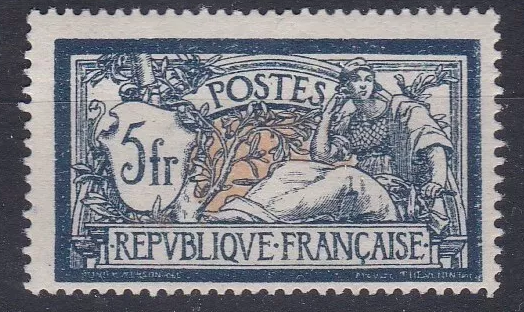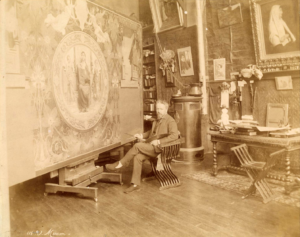The Merson key type design is a shining example of the artistry and sophistication of late 19th- and early 20th-century French philately. First issued in 1900, this iconic stamp series is widely regarded as a milestone in the world of stamp design, admired by collectors for its intricate detail, historical context, and innovative approach.
Luc-Olivier Merson
The Birth of the Merson Design
Named after its designer, Luc-Olivier Merson, this stamp series was introduced as part of France’s attempt to create high-denomination postage stamps that blended artistry with utility. Merson was a celebrated artist and illustrator, and his expertise shines through in the delicate yet elaborate designs of the stamps.
The key type was used primarily for high-denomination stamps ranging from 1 franc to 5 francs. These values were intended for international and parcel post use, which explains the detailed, dignified design befitting their important role.
A Closer Look at the Design
The Merson design is a visual masterpiece, combining classical motifs with symbols of the French Republic. The 5-franc stamp, one of the most iconic in the series, features:
- A reclining allegorical figure representing France, seated in a serene pose with a thoughtful expression.
- A shield displaying the denomination, framed by floral wreaths and scrollwork.
- Background detailing that includes agricultural and industrial symbols, signifying progress and prosperity.
- The inscription “REPUBLIQUE FRANÇAISE”, highlighting the stamp’s national identity.
The use of deep, rich colours like indigo and carmine enhances the visual appeal, with each denomination issued in distinct hues.
Printing and Distribution
The Merson stamps were produced using intaglio printing, a process that allowed for exceptional detail and depth. This technique was labour-intensive but perfectly suited to capturing the intricate lines and shading of Merson’s artwork.
Initially printed on watermarked paper, later issues used unwatermarked paper. The series saw various perforation types, and minor differences in printing methods and paper types make it a rich area for specialists to study and collect.
Legacy and Influence
The Merson key type stamps were in use until the 1930s and served as a template for other countries under French influence. Their artistic and technical excellence inspired subsequent designs, setting a high standard for philatelic artistry.
For collectors, these stamps represent a high point in French philately. Their combination of beauty, historical significance, and technical achievement makes them a prized addition to any collection.
Collecting the Merson Series
Due to their high face values, Merson stamps were often used on large parcels or important correspondence, which means finding them in good condition—especially with clear postmarks—can be challenging. Mint examples, particularly from the early issues, are highly sought after and can command premium prices. and herein below the list of the printed stamps with this design.
1900 (4 Dec)—06. P 14×13½
- 40c. red and pale blue
a. Coloured background, omitted - 45c. deep green and blue (1906)
- 50c. cinnamon and lavender
a. Coloured background omitted - 1f. lake and yellow green
a. Coloured background omitted - 1f. deep lake and yellow green
- 2f. deep lilac and buff
- 5f. deep blue and buff
1916-19. Types as before, but on greyish granite paper (“G.C. papier de Grande Consommation”). P 14 x 13½.
- 40c. red and pale blue
- 45c. deep green and blue
- 50c. cinnamon and lavender
- 1f. lake and yellow green
1920-26. Colours changed and new values. P 14×13½
- 60c. violet and blue (1.6.1920)
- 2f. orange and blue green (4.6.1920)
1925–32. New colours and values. P 14×13½.
- 3f. deep violet and blue (27.7.1925)
- 3f. deep mauve & carmine (20.8.1927)
- 10f. sage-green and red (8.1926)
- 20f. magenta and green (8.1926)
Conclusion
The Merson key type design stands as a testament to the intersection of art and functionality in stamp production. Its intricate details, historical relevance, and enduring appeal make it a cornerstone of French philatelic history.
Have You Collected Merson Stamps?
Have you encountered any rare variations or fascinating postmarks on Merson key type stamps? Share your stories and pictures in the comments below, and don’t forget to subscribe for more explorations into the captivating world of stamps and postal history!



